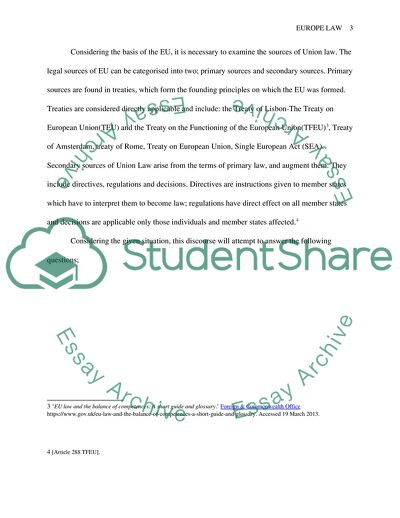
- Home
- Free Samples
- Premium Essays
- Editing Services
- Extra Tools
- Essay Writing Help
- About Us
- Studentshare
- Subjects
- Law
- The Sources and Basis of Union Law
The Sources and Basis of Union Law - Assignment Example

- Subject: Law
- Type: Assignment
- Level: Undergraduate
- Pages: 22 (5500 words)
- Downloads: 0
- Author: elliott33
Extract of sample "The Sources and Basis of Union Law"
The EU is comprised of various institutions each performing different functions. These institutions are:- the European Council, European Parliament, European Commission, Council of the European Union, and the Court of Justice of the European Union.1 The European Council lays down the general procedures for EU policies and is comprised of the heads of state of member countries. The European Parliament is directly elected by European Union citizens and approves proposed laws and evaluates the EU budget. The European Commission is comprised of independent members, one from each of the member states, and puts forward legislation for approval by the European Parliament.
The Council of the European Union decides EU laws. The Court of Justice of the European Union, comprised of 3 courts-Courts of Justice, General Court, and Civil Service Tribunal- uphold EU law, rule on how to interpret EU law, and ascertain that laws are applicable in the same manner in all member states2. Considering the basis of the EU, it is necessary to examine the sources of Union law. The legal sources of the EU can be categorized into two; primary sources and secondary sources. Primary sources are found in treaties, which form the founding principles on which the EU was formed.
Treaties are considered directly applicable and include the Treaty of Lisbon-The Treaty on European Union(TEU) and the Treaty on the Functioning of the European Union(TFEU)3, the Treaty of Amsterdam, the treaty of Rome, the Treaty on European Union, Single European Act (SEA). Secondary sources of Union Law arise from the terms of primary law and augment them. They include directives, regulations, and decisions. Directives are instructions given to member states which have to interpret them to become law; regulations have a direct effect on all member states and decisions apply only to those individuals and member states affected.
4 The United Kingdom joined the EU in January 19735 and signed the Treaty of Rome. EU law became effective in the UK through the European Communities Act of 1972.
...Download file to see next pages Read MoreCHECK THESE SAMPLES OF The Sources and Basis of Union Law
Constitutional law of the European Union
The European Union Law
Principle European Union Institutions
The Main Institutions of the European Union
European Union Institutions and Law
European Union Law
To What Extent Have External Sources Affected Development of the Law in England and Wales
Employee Relations in Context: A Trade Union or Labour Union

- TERMS & CONDITIONS
- PRIVACY POLICY
- COOKIES POLICY